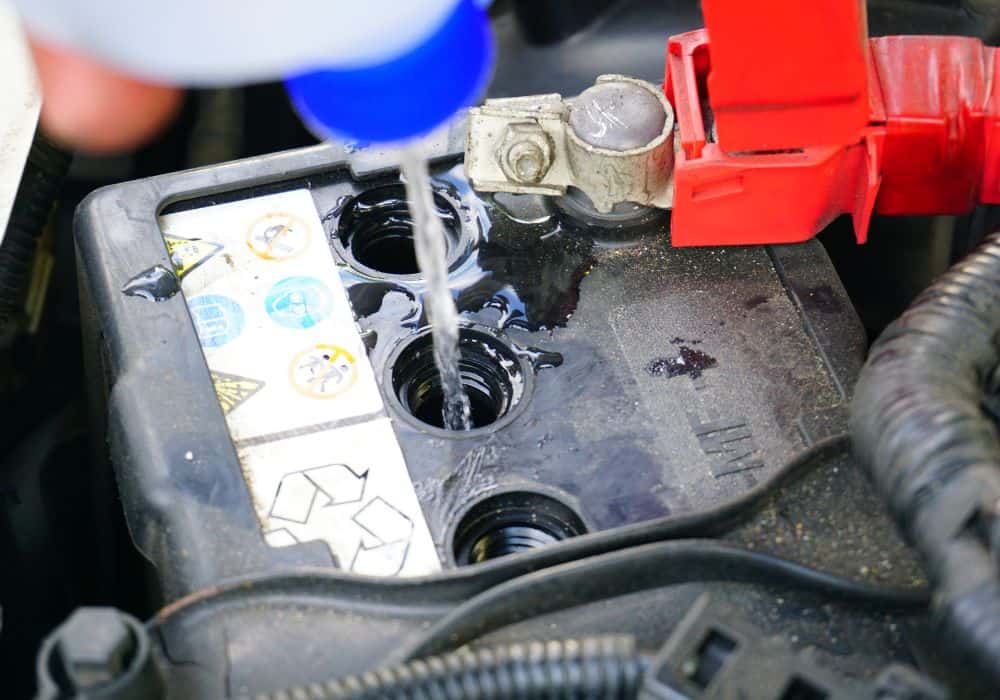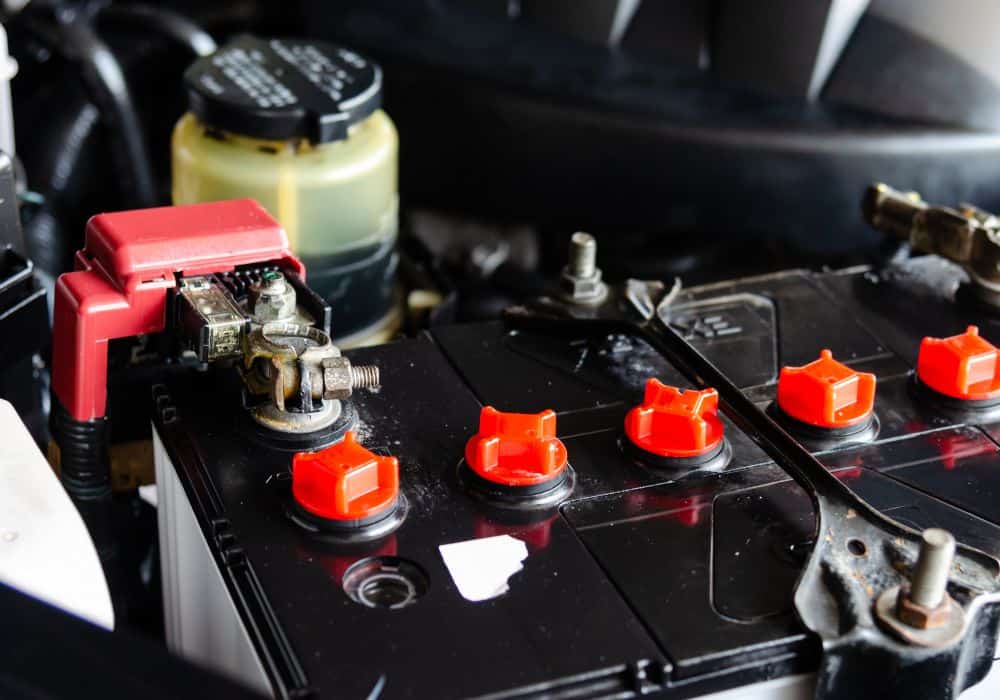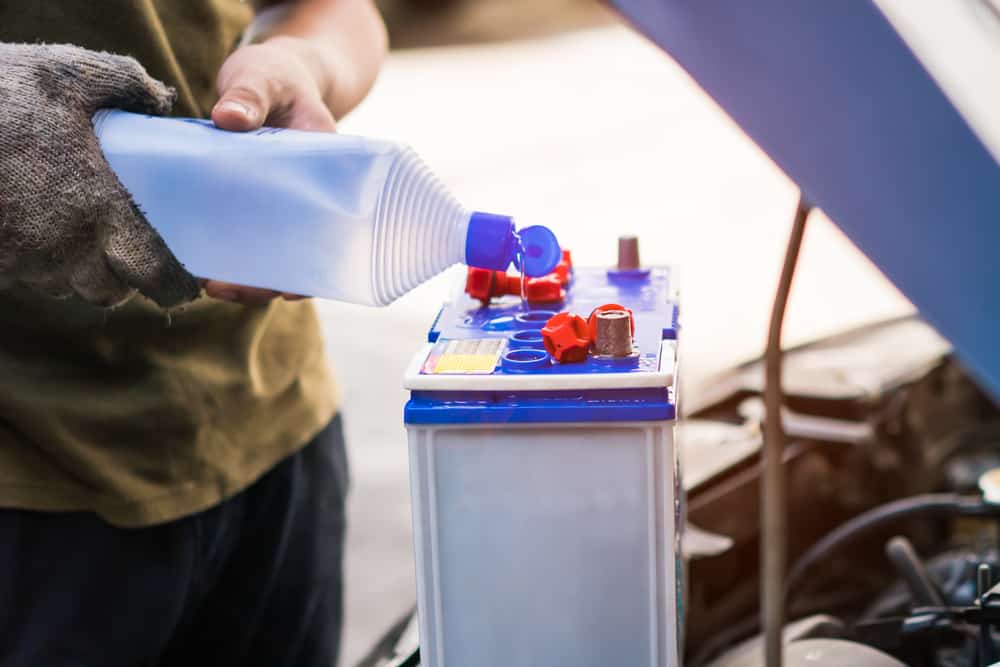You know that batteries need a lot of care, but how do you know when your car battery needs water ASAP?
The good news is your car is not a plant that you need to water regularly – but it does need a top-up every so often. It will tell you when it needs water, the signs of which I’ll discuss at length below.
Table of Contents
How Do You Know if Your Car Battery Needs Water?
The good news is your car will tell you if it needs water. But you have to pay attention to the signs, such as these three:
1. Indicator Light is Dark/Yellow
There’s a light on top of the battery that will tell you if it needs refilling. That’s why you need to check your non-maintenance-free (NMF) or wet cell batteries regularly (at least every six months.)
Of course, if you have a sealed, maintenance-free battery – then you don’t need to check it at all.
If you’re unsure about which one you have, know that a maintenance-free battery doesn’t have a vent cap. More often than not, it’s labeled ‘maintenance-free.’
If you see a green light in your NMF battery, then it means that the car battery water level is still good. In other words, it’s still 1/2 inch or 1 cm above the plates.
And, should you refer to the bottom of filler tubes, this means that the water is 1/8 inch or 3 mm below them.
If the light has gone dark, then this means the battery requires some water. If the light is yellow, then it needs assistance. As such, you should need to bring it to your car mechanic ASAP.
2. Battery Corrosion
When your battery runs out of water, the more the plates get exposed. And, as levels fall further, electrodes get exposed to oxygen – thus leading to their untimely corrosion.
As if things couldn’t get any worse, the negative electrode ends up reacting with both oxygen and sulfuric acid. This leads to less production of lead sulfate, which, in turn, decreases the electrolyte solution even further.
3. Car Problems or Battery Issues
If there are low fluid levels, then the battery’s performance will surely be affected. This can manifest as:
- The battery is frequently out of charge
- No crank/slow crank starting conditions
- Battery light/alternator light flickering
- Check Engine Light remains on
Why Car Batteries Need Water

Water is vital for the battery’s chemical reaction processes. Together with sulfuric acid, it helps create the electricity that makes your car run.
Since the battery discharges and recharges, it needs to be refilled occasionally. If not, the water levels will run dangerously low, the electrolyte solution will end up being ‘out of balance.’
In other words, the battery cells will become too acidic – thus leading to sulfation of the lead plates.
And, since these lead sulfate crystals are non-conductive, they can affect the flow of power through the solution. Worse, this buildup may end up shortening battery life.
Why Batteries Run Out of Water
Even if you water your car battery regularly, this doesn’t necessarily mean that the levels will stay put forever. Some circumstances will lead to its quick depletion, such as:
1. Overcharging
If you use a battery charger without a float mode or ambient temperature sensor, you may end up overcharging your car batteries. Unfortunately, this is usually the reason behind accelerated water loss.
When you overcharge a battery, more current flows into it.
Again, if your charger doesn’t have a sensor, it could allow more electricity to flow – even though it’s already a fully charged battery. This could lead to the decomposition of water – as well as the battery’s early aging.
Overcharging can also lead to thermal runaway, where more current is pushed as a result of the battery capacity being increased. If left unchecked, this process can destroy a lead-acid battery in a matter of hours.
Here’s how to check if your car batteries have been overcharged.
2. Extreme Temperatures
Extreme temperatures also contribute to the faster depletion of battery fluid levels.
During the summer, temperatures are hotter so evaporation happens more quickly. As such, you may find the water levels going down easily whenever it’s sweltering.
Colder temperatures, on the other hand, will mean that it’s harder to start your car. This, together with thicker motor oil, will prod the alternator to charge the battery longer – at a higher rate.
Similar to overcharging, this event will make the water dry up and decompose easily.
How to Add Water to Your Battery
As I’ve mentioned, water plays a vital role in your car batteries. As such, you need to be careful when topping it off.
According to an expert video, here’s the correct way of doing it:
1. Wear gloves and goggles!
If you get splashed with battery acid, make sure to wash the affected area with soap and water.
2. Make sure the engine is off and cooled.
You don’t want to get burnt during the watering process!
3. Locate the battery. Check it to see if it is fully charged.
The battery is often found under the hood, although models such as BMW and Mercedes Benz have their batteries in the trunk. Cadillacs, on the other hand, have their batteries under the seat.
If you aren’t sure about your battery’s charge, then use a voltmeter to check the battery terminals. The reading should be 12.6 with the engine off. You can also use a battery hydrometer to check the pH (it should be 1.265 or higher.)
Checking for the battery’s specific gravity will help you determine its charge as well.
Remember: when you water a dead battery, the fluid will just boil over when you charge it. If there is not enough space in the battery, the acid will just spill out.
4. Clean the case.
Use a quart of water and 1/4 cup of baking soda. Flush it with clean water to remove the gunk and dirt buildup.
You can also use an ammonia-based cleaner – sprayed on your rag/paper towel instead of the battery directly – to remove grime and corrosion.
If you want, you can also remove the battery to tidy it up thoroughly. For more info about cleaning a car battery, watch this video.
5. Pry the two caps open (each covers three cells.)
Use a flat plastic scraper. Avoid using any metal item to remove these caps.
If there is some dirt on the caps, make sure to clean them with a window-cleaning solution. Doing so will help prevent the onset of corrosion.
6. Carefully pour distilled water or deionized water into the holes so that you cover the tops of the battery plates.
You can use a cup or funnel to control the flow of water. Don’t use tap water as it will introduce minerals and debris that will have a negative effect on the battery’s chemistry.
Watering your battery is important, but you shouldn’t be too careless that you end up overwatering it. When you do this, you dilute the electrolyte solution. The battery won’t be able to hold enough charge, leading to poor performance.
7. Put the caps back on.
Maintaining Your Battery
Apart from topping your battery fluid regularly, doing the tips below will keep your battery performing well – for longer:
- Drive your car regularly. Remember: your battery will only get charged whenever the engine is running.
- If you decide to keep the batter idle for quite some time, make sure to affix it to a maintenance charger. Likewise, you may opt to disconnect the cables (remember to remove the one marked negative first.)
- Don’t let the battery drain completely. This will lead to a discharge, which, in turn, drastically reduces battery life.
- Make sure your battery is clamped down securely. Vibration can damage the battery and lead to early failure.
- Inspect the battery leads for cuts, breaks, or corrosion.
- Check the battery terminals for corrosion, damage, or cracking at least every six months.
- Have your battery tested and serviced regularly.
When to Get Replacement Batteries

Let’s say that you water your free batteries regularly. While this will help, a battery is not meant to last forever. Generally, it will work for three to four years (even five or six years, depending on usage.)
So if you don’t want to have a dead battery in the middle of nowhere, then you need to pay attention to these signs that you need new batteries ASAP:
- Misshapen/warped battery
- The engine struggles to take a few moments to start even if the car has just ‘sat’ in your garage.
- Lights dim when you say, turn on the radio
- Tripped engine light
- A buildup of white ashy substance on the battery
Conclusion
Your car battery needs water if:
- The indicator light is dark/yellow
- There are signs of corrosion
- There are widespread car/battery issues
For best results, make sure to check your battery’s fluid levels every six months. Likewise, it will be prudent to have it examined by a professional regularly.
Have questions about maintaining car batteries and whatnot? Post a comment below and I’ll be more than glad to answer you!
